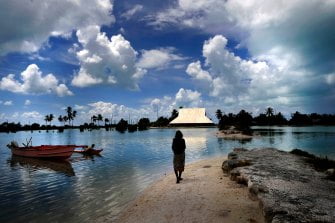How global warming would affect the world with just a 3-degree temperature rise
The reef had already started turning white when the little rat vanished. No one knows exactly how the rare rodent, known as the Bramble Cay melomys, first came to live on a tiny island at the tip of the Great Barrier Reef. But about a decade ago, the very last of them were wiped out, likely swept away by rising seas and storm surges in what is considered the world’s first mammal extinction caused by climate change.
Our planet is changing fast and not just for unfortunately situated rodents. Climate science is concerned with what’s in the air – the invisible, planet-warming build-up of carbon dioxide. But you no longer need graphs to see the impact. Rainforests are creeping into savannah. Ice sheets are plunging into the sea. Bright coral reefs are fading to white.
Six years ago, just months before Queensland researchers declared the Bramble Cay melomys extinct, world leaders met in Paris and agreed to keep global warming below 2 degrees (and as close to 1.5 degrees as possible). Yet, despite a slight decline in pollution in 2020 because of pandemic shutdowns and despite a new surge in commitments from governments to slash their emissions to net zero by 2050 (or 2060 in the case of China), the shift to a green economy isn’t happening fast enough.
Australia has already warmed by about 1.4 degrees since the Industrial Revolution and the latest expert analysis for the United Nations says the globe is still headed for a 3-degree rise by the end of the century. Patricia Espinosa, executive secretary of UN Climate Change, has likened our current course to “walking into a minefield blindfolded”.
Leading Australian scientists have considered what a 3-degree rise in global temperatures will look like for Australia in new detail, in a report from the Australian Academy of Science.
But they stress that the path out of such a future is still before us. While the 1.5-degree target will almost certainly be surpassed, if countries immediately set credible targets for 2030, we may still reach net zero by 2050, holding warming to about 2 degrees. Borrowing a well-worn phrase from the COVID pandemic, the report authors liken it to “flattening the curve” of climate change. Of course, even a delay of a few years could see us miss that deadline too – and set off dangerous climate “tipping points”.
So how far away are 50-degree summers in our major cities? What will global warming mean for our natural environment and for agriculture? How do tipping points work? And how can we avoid the worst of the climate fallout?

On the Pacific island of Abaiang, people must use a boat to cross from one side of a village to another at high tide as the sea creeps further in.Credit:Justin McManus
What would 3 degrees look like in Australian cities?
January 2020 was Sydney’s hottest January on record. On January 4, temperatures in far western Sydney nudged 50 degrees for the first time. Back then, Keith Heggart told the Herald and The Age how his airconditioner conked out and his family huddled inside, the curtains drawn against the sun and the windows shut against bushfire smoke.
Should Australia warm by 3 degrees, the number of days hotter than 35 degrees in Sydney would jump from an average of 3.1 to 11 each year, while in Melbourne the jump would be from 11 to 24. In Darwin, the average number of days hotter than 35 degrees would go from 11 to 265 – every day would be designated a heat stress day.
According to Professor Lesley Hughes of Macquarie University, the number of heatwaves would jump from three to seven a year and their duration would blow out from seven to 16 days. “Heatwaves are the silent killer in Australia. They’re responsible for more deaths than any other climate-related disaster but they also affect our agricultural productivity,” says Hughes.
Cities and towns will need more tree cover, and some outdoor sport will probably move inside, while airconditioning systems (and the electricity grid) will need to be optimised to avoid blackouts.
As the temperature soars, diseases normally found in the tropics could also spread to more temperate areas across Australia, including cities, the report says, noting climate-sensitive infectious diseases such as the Ross River virus will be of particular concern.
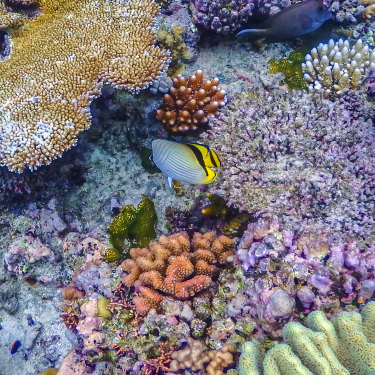
The vibrant corals of rhe Great Barrier Reef, one of the seven natural wonders of the world, are not expected to survive much longer as the planet continues to warm.
What about the rest of Australia?
Australia’s high levels of heating have already led to mass bleaching events that have killed about half the hard corals in the Great Barrier Reef and contributed to the droughts, fires and floods of recent years, says Hughes. At 1.5 degrees we will lose between 70 and 90 per cent of today’s corals but by 3 degrees 99 per cent will be gone, says Professor Ove Hoegh-Guldberg, one of the report’s authors. That almost certainly means no more Great Barrier Reef.
The kind of heat likely to come to Darwin is also expected across the entire Top End, severely affecting livestock and the people who manage them, according to the report. A 3-degree rise would reduce yields of key crops by between 5 and 50 per cent. Significant reductions are expected in oil seeds (35 per cent), wheat (18 per cent), fruits and vegetables (14 per cent), plant fibres (7 per cent), rice (2 per cent) and other fibres (11 per cent) in Australia. Already today, broadacre crops such as wheat and barley have fallen in profitability by up to 22 per cent since 2000.
And it’s not just the heat that would be the problem. While severe, damaging storms will increase, rainfall overall will fall. The report predicts a 13 and 21 per cent drop across the Murray-Darling Basin, with hotter areas set to be far drier.
Australia is home to some of the most unique ecosystems in the world but they are already radically changing, and extinctions accelerating – and that could have big impacts on the tourism and recreation industries that rely on our wild places. At 3 degrees, many Australian ecosystems would simply be “unrecognisable”, the report says.
During the Black Summer bushfires of 2019-20, an area roughly three times the size of Tasmania burnt including 80 per cent of the World Heritage Area in the Blue Mountains and 50 per cent of the ancient Gondwana rainforests on the east coast. These are forests, says Hughes, that may not have burnt for thousands of years. For wildlife, it was the single biggest catastrophe in recorded history – 3 billion creatures were killed or displaced.
Loading
At 3 degrees, Hughes says, we would see an increase of between 100 and 300 per cent in such extreme fire days. Most seasons will look like that record-breaking Black Summer, when smoke blanketed cities and flames raged for months, at times in every state at once.
Such fierce bushfire seasons will also change the shape of our urban fringes and small towns, experts predict, as more people move out of remote bush. Insurance premiums will go up, and water will probably be more heavily regulated as it grows scarce.
Well-loved holiday spots and hamlets along the coast could also be swept away under rising sea levels. The Earth’s melting glaciers have already caused a rise of 14 millimetres between 2003 and 2019. If the sea rises by one metre by the end of the century, the report says an estimated 160,000 to 250,000 Australian properties will be at risk of coastal flooding.
Just as we adapt to fire and heatwaves, we will need to rethink how we live with floods. The hard surfaces used for driveways and footpaths may even be replaced with more permeable surfaces in the future.
Under most modelled scenarios, what would have been one-in-100-year coastal floods will be happening almost every year by 2100. Should temperatures rise between 2 and 3 degrees, the coastal flood area is projected to expand by about 33,200 square kilometres across Australasia, the report says. The impact would be particularly severe on Australia’s densely populated east and south-east coasts. Properties on flood plains and in storm-surge zones in south-east Queensland would have a 33 per cent increase in tropical cyclone risk under a 3 degree warming scenario.
How would the rest of the world look at 3 degrees?
A world at 3 degrees is not a pretty picture anywhere, but parts of the world are warming faster and are likely to suffer more than others. Australia, already the land of drought and flooding rains, is not in a good position but many of its Pacific Island neighbours face total wipeout because of rising sea levels. And more “dead zones” are expected to open up at sea. As the waters acidify and warm, algae blooms will explode at the surface, starving marine life of oxygen. On land, some species are already adapting to rising temperatures, including by moving to cooler altitudes, but most will struggle to keep up with the wicked pace of a 3-degree rise by the end of the century.
People, in their hundreds of millions, will also be battling more displacement, monster storms, disease outbreaks and famine if we hit that temperature. The United Nation’s special rapporteur on extreme poverty and human rights, Philip Alston, has warned the world could face a kind of “climate apartheid” where only the rich can escape the worst of global warming. Africa, Asia and the Middle East, in particular, look set for more food and water insecurity.
Loading
Meanwhile, both El Nino and La Nina events are tipped to ramp up near Australia, but the powerful North Atlantic current, which carries warm water from the tropics up to North America, appears to be slowing down. This could cause unexpected cold snaps in parts of Britain, western Europe and the United States, further destabilising ecosystems as the same countries grapple with punishing drought and heat elsewhere.
Three degrees might not seem a lot when we check our own daily weather forecast. But, as the report notes, 5 or 6 degrees is all that separates the Earth’s average surface temperature during the last ice age 20,000 years ago and its temperature today, and a whole lot was different back then. Half the planet was covered in ice, for one, and the sea was at least 100 metres below where it is now.
In that case, those 5 degrees of warming crept in over millennia. Today’s human-driven climate change is happening lightning fast. Three degrees or more could now make vast swathes of the planet uninhabitable again, the report says, resulting “in a very different biosphere hardly recognisable compared to the conditions of the past 10,000 years in which humans have thrived, and one that would present significant challenges even for the technologically advanced society of today”.
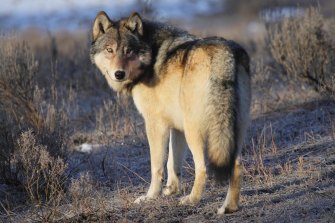
Scientists say apex predators, such as this grey wolf in America’s Yellowstone national park, may help their ecosystems adapt to climate change, if they can stay ahead of temperature rises themselves.
What are climate tipping points?
Imagine rolling a ball up a hill. At first, you need to push it up the slope or it will keep rolling down but, once you reach the top of the hill, it will tip over and its momentum alone will drive it down the other side. That moment is the tipping point.
Of course, in climate science, the ball we are talking about is a vast, living Earth with many different systems, all interwoven, from its oceans to its winds. So there isn’t just one clear tipping point, there are many. And the changes wrought by global warming could set them off in a cascade. Like a game of climate Jenga, at that point small changes can make a big difference, shaking the whole system.
Climate tipping points were once dismissed as alarmist and, by their very nature, too difficult to predict. Now, as they have emerged more clearly in the science, experts are increasingly warning that climate change could become its own self-fulfilling feedback loop, one that slips beyond our control if we don’t cut emissions fast.
Take the Amazon rainforest, which helps shape the world’s weather. When people burn and log it for farming and timber, less moisture evaporates from the forest’s leaves to become rainfall, which drives drier conditions and more fires that eat the forest and so on – soon the jungle itself could reach a tipping point and turn into savannah. Or consider the massive Greenland ice sheet up north. As it rapidly melts and shrinks, more of the remaining ice is exposed to warmer temperatures, accelerating melting. And, if the world loses the reflective cover of its two polar ice caps, many experts say the climate system will unravel no matter how quickly emissions fall.
Loading
Until recently, most climate analysis assumed warming would increase at relatively the same rate as the build-up of carbon in the atmosphere. And that it would stabilise once humans got to net zero emissions. But if the world crosses a major climate tipping point, things could go haywire, even if we meet our targets thereafter.
Many of the key biological tipping points are already active, from the thawing permafrost releasing millennia of stored carbon to large-scale coral reef die-offs. Even the loss of that little rat off the coast of Australia created a gap in its local ecosystem. These gaps are building up all over the world as extinction rates skyrocket, and they could spell trouble for the broader biosphere, our life support system on Earth.
As the report’s authors say, at no other time in the geological record, save the fallout from the meteor that killed the dinosaurs, has the world’s climate changed as fast as it is now as a result of human emissions.
The greater the warming, the greater the risk of crossing a tipping point. Three degrees “means an increasing risk that planetary systems will fail, irreversibly pushing Earth towards a much hotter state with an increasing risk of rapid and effectively irreversible changes”, the report says. But scientists agree there is still time to pull back from the brink.
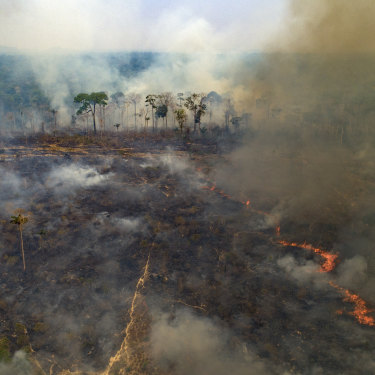
Large areas of the Amazon rainforest have burnt in recent years, often due to farming and land-clearing. Scientists fear too much fire in the “lungs of the planet” could trigger a tipping point of irreversible landscape change from jungle to savannah. Credit:AP
So what’s the way forward?
Despite all that bad news, experts stress that the window to avoid 3 degrees has not closed yet, and the costs of getting there are actually far cheaper than once thought.
Wind and solar are now in a position to largely replace fossil fuels in Australia’s energy system, says Professor Frank Jotzo, director of the Australian National University’s Centre for Climate and Energy Policy and a contributor to the report. And, because they are so much cheaper than coal or gas, we can afford to introduce them and spend on storage technologies such as batteries and pumped hydro, as well as necessary changes to the grid. Other experts have suggested the government subsidies now used to prop up fossil fuel industries could be spent supporting their workers into new jobs as old plants and mines shut.
Loading
After electricity, transport makes up a big chunk of Australia’s emissions. The report’s authors say electric cars will need far more support to displace our older internal combustion fleet.
We need to stop chopping down trees, too, but while agriculture is commonly seen as a difficult industry to decarbonise given our reliance on it for food, new technologies and greener farming methods could lead the way if given investment.
As the world prepares for the next major UN climate talks in Glasgow in November, nations have been declaring stronger climate ambitions. Over the past year, the amount of the global economy operating under a mid-century, net zero target has leapt from 25 per cent to 75 per cent.
Now the UN is pushing nations to declare steeper cuts for 2030. On April 22, US President Joe Biden will host 40 world leaders at climate talks where he is expected to lend America’s clout to the cause.
All this is going on during another major global catastrophe, a pandemic. But while COVID has distracted nations from climate policy, experts say it has also shown them two key things: that big, “unprecedented” transformations are possible – fast; and what can happen when politicians take the gloomy warnings of scientists seriously.
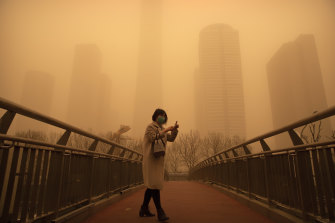
Air pollution has long caused health problems in Beijing, which was also hit by a sandstorm in early 2021.Credit:AP

